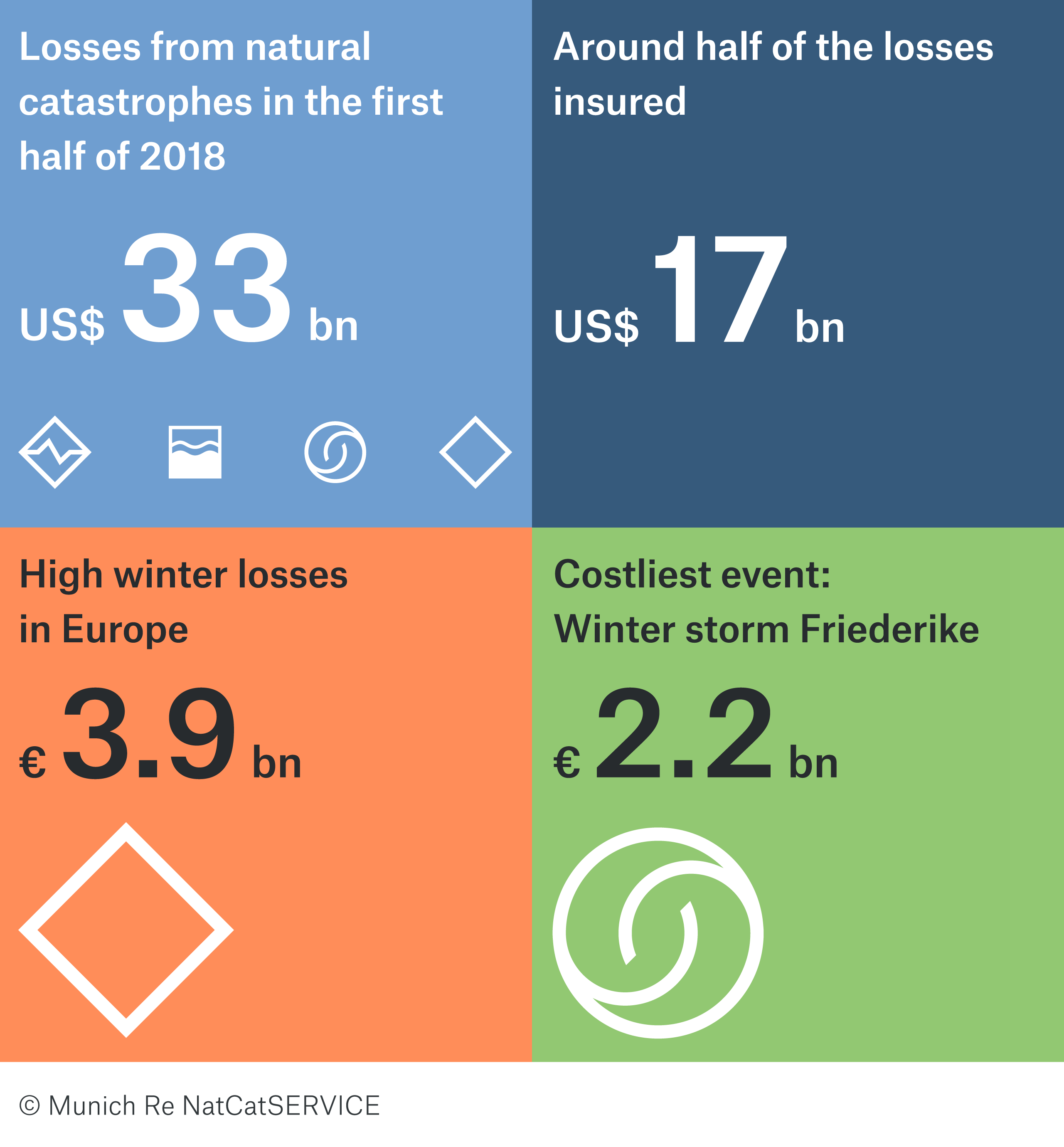Fewer severe natural disasters in the first half of the year; overall losses below the average
07/11/2018
Reinsurance
properties.trackTitle
properties.trackSubtitle
- The first half of 2018 was fortunate in that natural disasters across the world caused significantly lower losses than usual. According to provisional figures, overall losses were around US$ 33bn, the lowest level since 2005 (US$ 29bn after adjustment for inflation).
- However, individual events did cause high losses for those concerned, for example crop losses in the agricultural sector as a result of drought in Europe.
- Also, it is the second half of the year that usually brings higher losses. For example, in 2017 the series of major hurricanes, Harvey, Irma and Maria, pushed overall losses for the year to US$ 340bn.

Following a period of extreme disasters with record losses, it is nice to be able to record a phase with low losses. Of course, looking at a short timespan may distort the true picture. The most important thing is to understand the long-term developments. That is why we must continue to make every effort to understand the background to natural disasters, and provide safeguards against them in the form of intelligent prevention measures. This is borne out by statistics on flooding losses in Europe, which have generally decreased thanks to investment in flood protection and control.
Overview of natural catastrophe figures for the first half of 2018

- The overall losses of US$ 33bn were roughly half those of the previous year and of the price-adjusted average for the last 30 years (US$ 65bn and US$ 68.3bn respectively).
- At approximately US$ 17bn, insured losses were less than in the previous year (US$ 25.5bn), but more or less matched the average for the first six months over the last 30 years (US$ 17.5bn).
- Even so, some 3,000 people lost their lives in natural disasters in the first half of 2018, a lower figure than the 5,540 for the corresponding period last year. This reduction is particularly encouraging when compared with the long-term average of 28,000.
- The NatCatSERVICE database registered 430 relevant natural disasters in the first half of 2018, more than the long-term average (250) and the previous year (380). (Read more)
Winter losses prominent in the loss figures
Windstorms and cold weather in Europe and North America during the winter months feature prominently in the statistics for the first half of the year. The most destructive event was Storm Friederike, which swept across the United Kingdom, northern France, the Benelux states and Germany in mid-January, with speeds of up to 150 km/h on flat terrain and 200 km/h in elevated areas. Thousands of buildings and motor vehicles were damaged. In Germany, long-distance train travel was disrupted after uprooted trees had torn down the overhead lines in many places. Overall losses came to €2.2bn (US$ 2.7bn), of which €1.7bn (US$ 2.1bn) were insured, reflecting the high insurance density of windstorm cover in Europe. Roughly two thirds of the losses occurred in Germany. Just a few weeks previously in the same regions, Storm Eleanor (known in Germany as Burglind) had caused damage close to the billion euro mark.
With biting cold and snow, winter held Europe and North America firmly in its grip until well into March. Between the end of February and mid-March, North America was hit by several widespread snowstorms, known locally as “nor’easters”. These are large low-pressure systems originating in the southwest that batter the shoreline with strong northeast winds as the storm moves up along the east coast. Nor’easters are frequently accompanied by heavy snowfalls and can herald extended periods of frost in eastern North America. The most destructive event was a blizzard in the first week of March, which caused overall losses of US$ 2.2bn, of which US$ 1.6bn was insured.
In total, winter losses in Europe came to €3.9bn (US$ 4.8bn), of which €2.9bn (US$ 3.6bn) was insured. The winter in North America caused overall losses in the first half of the year totalling US$ 3.8bn and insured losses of US$ 2.7bn.
Thunderstorms and drought in Europe
An unusual weather pattern developed in central Europe in May and early June. In the south and west of Germany, as well as in France, a series of very slow-moving thunderstorms formed in warm, moist air masses, triggering flash floods in many places. The flooding was caused by torrential rainfall that the storm sewers were unable to cope with. Overall losses from the storms came to around €1.6bn, with insured losses of at least €900m.
On the whole, losses caused by severe thunderstorms are rising in Germany – even after taking increasing values into account. While windstorm and hail losses enjoy a high level of insurance coverage, the share of insured losses from flash floods is usually well below 50%.
At around the same time, northeast Germany, Denmark, parts of Poland, Scandinavia, the Baltic states and the Balkans were experiencing very high temperatures and extremely dry weather. One result of this is that the grain harvest will be very poor in many of the affected regions. Many places fear downturns in yields, or even total losses, but the loss amounts can only be determined after the crops have been harvested.
The reason for both these phenomena was a stable weather pattern featuring a blocking high-pressure area over Scandinavia and an expansive low-pressure system stretching from western to central parts of Europe. Areas of central Europe recorded the warmest May since 1881, having just experienced the warmest April as well.
Ernst Rauch, Chief Climate and Geo Scientist at Munich Re, explained the background: “Although individual events like these cannot be attributed to climate change, climate model studies show that one future effect of the increase in temperature will be more frequent periods of heat and drought, along with more intensive convective rainfall. So these weather processes roughly fit the pattern that may be expected more frequently in future as a consequence of climate change.”
Major volcanic eruption in Guatemala
Oman hit by extremely powerful cyclone
At the end of May, Oman was hit by the strongest tropical cyclone ever registered on the Arabian peninsula. On 25 May, Cyclone Mekunu made landfall close to Salala, the Sultanate’s third-largest city, with speeds of 185 km/h, making it a Category 3 storm (the third-highest category) on the Saffir-Simpson scale. The cyclone also brought an enormous volume of rainfall: in the space of three days, there was between 300 and 600 mm of rainfall, equivalent to the average amount over four to eight years. According to initial estimates, overall losses could amount to several hundred million dollars, with about a third of these insured. 30 people were killed.
There is still not much known about the loss figures from the Mw 5.5 earthquake that struck the southern Japanese prefecture of Osaka on 18 June. The epicentre was located near the city of Hirakata. The tremors from the quake, which occurred at a fairly shallow level of 13 km, could be felt in both major cities Osaka and Kyoto. Several thousand buildings were damaged and the electricity supply for 170,000 households was disrupted. However, thanks to the very high building standards in earthquake-prone Japan, damage was kept within limits.
Find more details and charts on the natural catastrophe figures for the first half of 2017 in our Topics Online magazine.
Munich Re is one of the world’s leading providers of reinsurance, primary insurance and insurance-related risk solutions. The group consists of the reinsurance and ERGO business segments, as well as the capital investment company MEAG. Munich Re is globally active and operates in all lines of the insurance business. Since it was founded in 1880, Munich Re has been known for its unrivalled risk-related expertise and its sound financial position. It offers customers financial protection when faced with exceptional levels of damage – from the 1906 San Francisco earthquake to the 2017 Atlantic hurricane season and the California wildfires in 2018. Munich Re possesses outstanding innovative strength, which enables it to also provide coverage for extraordinary risks such as rocket launches, renewable energies, cyberattacks, or pandemics. The company is playing a key role in driving forward the digital transformation of the insurance industry, and in doing so has further expanded its ability to assess risks and the range of services that it offers. Its tailor-made solutions and close proximity to its customers make Munich Re one of the world’s most sought-after risk partners for businesses, institutions, and private individuals.
Disclaimer
This media information contains forward-looking statements that are based on current assumptions and forecasts of the management of Munich Re. Known and unknown risks, uncertainties and other factors could lead to material differences between the forward-looking statements given here and the actual development, in particular the results, financial situation and performance of Munich Re. The Company assumes no liability to update these forward-looking statements or to conform them to future events or developments.